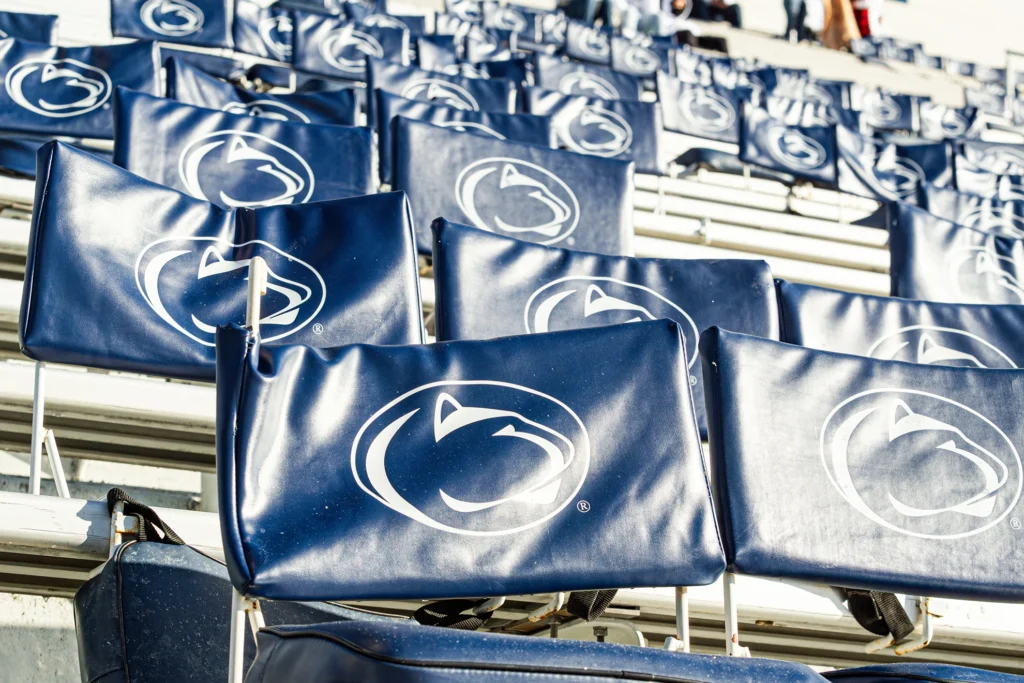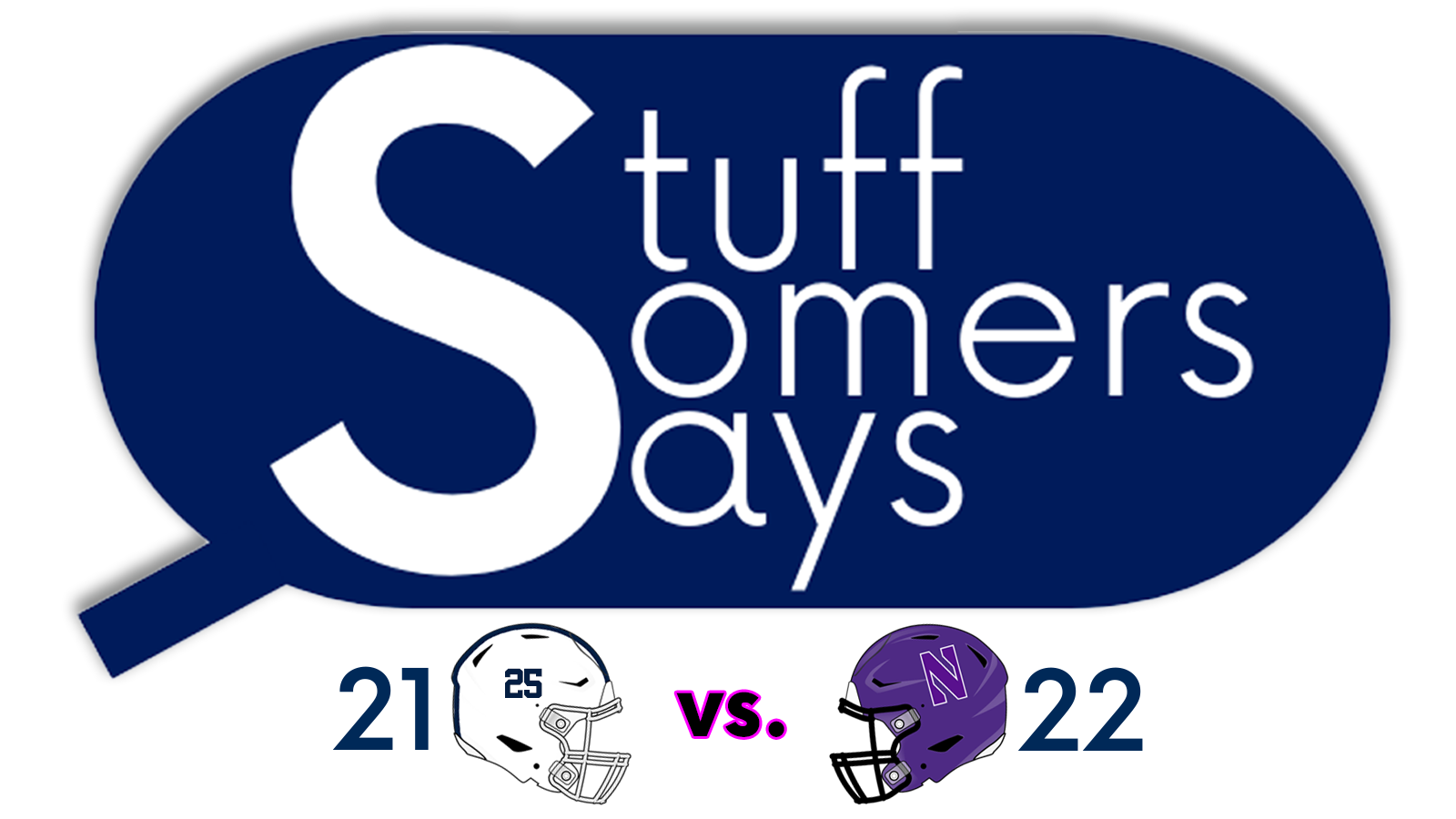
It’s all business in college sports these days and things at Penn State are no different – from big-budget partners controlling how the program gets promoted and sold to the athletic department itself taking every opportunity to sell to its constituency, including pitches for limited edition watches and panoramic photos after the football team’s final two home games this season.
So, as some fans bask in the women’s volleyball national championship, prepare for the Fiesta Bowl, maybe travel to Chicago for a men’s hockey game at Wrigley Field, follow the efforts of the men’s and women’s basketball teams or prepare for another championship run by the wrestling team, here’s a look at seven of the biggest business- and media-related stories from the past year.
1. Pay For Play
Almost all the players on Penn State teams are getting paid these days — and that’s beyond scholarships, room and board and stipends. It’s called NIL for name, image and likeness, but that approach never really developed as intended here, or anywhere.
Under a true NIL model, more prominent players in any sport would strike a deal and get some money form sponsors because of their presence and promotional value. That happened with some restaurant and marketing efforts, but NIL quickly became college athletics programs simply paying their players.
It’s an important part of recruiting, transfers and the day-to-day business of an athletic department — thus the emergence of jobs like general managers and a second full-time financial staff position for Penn State’s athletic department.
Coaches in sports after football and men’s basketball often function as their own salary cap person or have a staff member who does so. Pay for play has become part of the DNA of college sports.
That’s all OK. It might not be something I’ll support, but things have changed. In terms of the business and sports media, my hope is that at some point we’ll get public salary data and reporting about that part of the business.
Especially if the programs want people to donate, you’d think donors would want some specificity about what’s happening with their money.
2. Beaver Stadium Concert
When Luke Combs attracted 73,339 fans to Beaver Stadium on a rainy night (April 27, 2024), it was proof of concept that with the right artist or event the stadium could host a potential money maker for the athletic department that was not a football game.
While construction at the stadium might prevent something like the next two offseasons, it seems likely that in spring 2027, at the latest, there might be another concert at Beaver Stadium.
By then the stadium will have more “premium seating,” which might broaden the scope of performers they could attract (and the money Penn State or the performer can make). The list of artists who can sell nearly 80,000 seats a night is limited, but reviews for the concert were strong, from both Combs and his people as well as those who attended.
When the time comes Penn State will be able to attract another performer who can fill a lot of seats in the stadium.
3. Playfly’s Arrival
It’s mostly a behind-the-scenes matter, and one that became moreso with the start of a new relationship as Playfly Sports became Penn State’s multimedia rights holder in July 2024. The Pennsylvania-based company with a growing portfolio of college programs and relationships across all major sports replaced longtime rights holder Learfield in that role.
For the most part, Playfly was less public than Learfield and just went about its business of selling Penn State. The value of its deal with Penn State has not been reported, but Nebraska has a 15-year, $300-million agreement with the company so it’s hard to imagine Penn State is less valuable.
As fans, watch for new advertising partners and activations going forward. It seems like there’s been a bit of value setting through the first few months of the relationship, and even internally Penn State has some people willing to sell what’s inside Beaver Stadium, for example, and others seeking a more ad-free environment and making the place seem clean and special.
Playfly helps Penn State with NIL efforts and much more. It has a big presence and impact, with 16 staff members listed on the athletic department’s online staff directory.
4. White Out And “White Out Energy”
It might be the most debated and talked about thing related to Penn State athletics that’s important but also difficult to quantify. What to do with the White Out.
Sure, in an ideal, you-control-everything world, Penn State would play the football game at night against the sexiest opponent each fall (that’s Oregon on Sept. 27, 2025, if you’ve not already looked ahead), but it’s not an ideal world.
Big Ten Conference broadcast partner Fox is heavily invested and its money matters. It draws big ratings and attracts advertisers who support games that kick off at noon. So, Penn State’s biggest game, like that one against Oregon next fall, would make sense at noon.
Of course, that makes some at Penn State, and many of its fans, lose their ever-loving minds — as if that game has a birthright to be at night. Again, ideally, yes, but if you’ve sold your soul, sometimes you just must adapt.
Plus, the atmosphere and success of the noon playoff game as well as the short turnaround for “White Out energy” by James Franklin in advance of the Illinois game have shown Penn State fans can bring energy to Beaver Stadium at any time.
Everything White Out was as success this past football season.
What will be interesting is what Penn State decides to do with it going forward. Will it, for example, tab Oregon for the White Out as soon as it can next spring? Just deciding to own the event and make it work no matter what time it gets assigned for TV?
Or will it try to lobby behind the scenes to get something done? Or will it cajole, complain and whine publicly to get what it wants?
It’ll be interesting to watch — all keeping in mind that the game itself has a good PR and visual impacts while at the same time offering no additional seats in the stadium to drive revenue or really driving a big difference in TV viewership (other than the equality of the opponent). So, the effort invested in protecting it always seems curious from that aspect.
5. Women’s Volleyball Championship And Viewership
Viewership of the women’s volleyball tournament was up 41 percent year over year on ESPN, with 1.3 million viewers watching as Penn State claimed the championship by betting Louisville in a match that aired on ABC.
The Sunday afternoon network timeslot meant more visibility for the sport and coach Katie Schumacher-Cawley’s battle with breast cancer provided a compelling storyline, along with the team’s determination and success.
Penn State became the face of the sport again while earning its eighth national championship. It was a good thing, with plenty of good moments for Penn State, beyond football and wrestling.
6. A Third BJC Wrestling Match
The success of the women’s volleyball team necessitated a venue change for the wrestling team’s home match against Wyoming on Dec. 15, and it provided a test case for what attendance would be like for wrestling match that was not against the likes of Iowa, Michigan or Ohio State.
About 7,300 fans turned out at Penn State blanked Wyoming, 54-0.
That’s a small crowd by BJC match standards — the program will get twice that many for bouts later this season against Iowa (Jan. 31) and Michigan (Feb. 7) — but it’s also about 1,000 more than can fit into Rec Hall for a match. And the Wyoming change came about with short notice as the women’s volleyball team advanced in its tournament.
So, with the BJC offering more amenities and bigger per-cap revenue opportunities with concessions and beer, there might’ve been a little fuel added to long-simmering discussion about more wrestling matches in the BJC.
7. LaVar Arrington’s parties
Maybe you attended. Maybe you just heard the commercials. Maybe you had no clue. But football letterman, NFL veteran, media personality and Penn State football parent LaVar Arrington hosted pregame parties at Medlar Field this past season.
Attendees to the STIX CITY Tailgate could pay to rub elbows with Penn State legends and eat and drink before games.
With LaVar Jr. joining the Penn State program early (he was one of a handful of incoming players joining the team during playoff practices) and with Arrington’s additional business interest in the athletic program, through an NIL effort (DisruptU PSU), watch for more of the same going forward.
Expect other former players and companies to try to explore ways to do something similar, too.
Looking ahead to 2025 …
What’s next and what will matter?
Well, the Beaver Stadium construction project obviously, and maybe a run to the NCAA Tournament by the men’s basketball team. Probably another national championship for the wrestling team.
Still, the biggest, most important thing remains pay for play, how Penn State handles paying its athlete and prepares for a changing national landscape in that area.
Because no matter the mentality, no matter that Penn State ranks, according to James Franklin, as a real college football program, and no matter if fans are solidly in the camp of their school doing it differently and better, often it comes down to talent – and these days that means talent that gets compensated.
So that’s what next and will remain so going forward.
If you’ve enjoyed this content, please subscribe to Stuff Somers Says With Steve on YouTube. Or join our newsletter by entering your email below.

